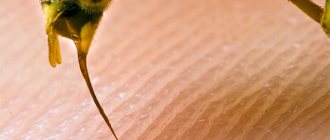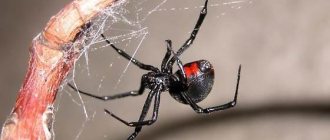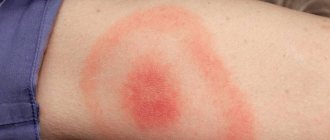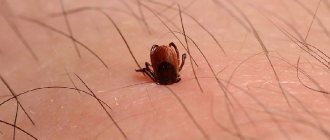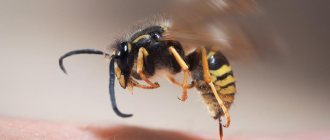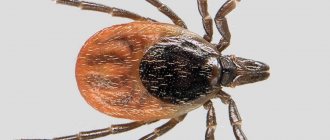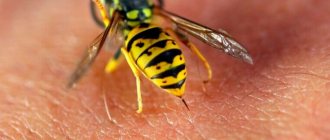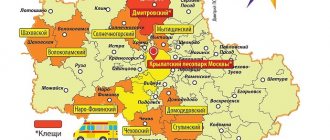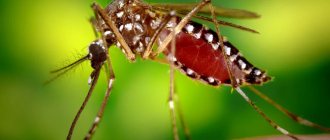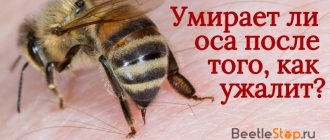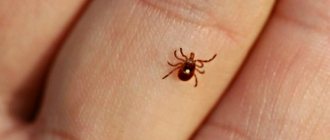The article was prepared by a specialist for informational purposes only. We urge you not to self-medicate. When the first symptoms appear, consult a doctor.
The danger of a spider bite depends on various factors. The clinical manifestations of this condition are determined by the immune abilities of the human body and the poisonous properties of a particular type of spider. The dependence is this: the more poisonous the spider, the more dangerous its bite, even for a person with perfect immunity. And, conversely, the stronger the immune response, the greater the likelihood of a relatively mild course of any bites.
Cross spider bite
The most common spider on all continents is the cross spider. Its name is due to the appearance of this arthropod. It is easy to recognize the cross breed by the characteristic white dots on its back that form a cross. The size of these spiders is not very large, although they can reach 2 cm without taking into account the spread of the legs. The cross does not attack a person purposefully. Usually, bites happen by accident when a person falls into its web, where it waits for its victim.
The bite of the cross spider is not dangerous to humans. Clinical manifestations are limited to local reactions in the form of redness of the skin, local swelling and painful reddened hardness, accompanied by a burning sensation. Rarely, general reactions such as a short-term increase in body temperature and mild chills may occur. This is possible if hemolysins and other toxins enter the systemic circulation of a person with an unstable immune response.
In typical cases, all manifestations go away on their own within a few days. If this does not happen, it is advisable to apply cold to the bite site, lubricate it with alcohol or anti-inflammatory ointments (kremgen, sinaflan). Under no circumstances should you scratch the bite site. This can cause an infection to enter the skin with the development of a purulent process.
Social structure and reproduction
Photo: Black Widow
Black widows usually mate in the spring and summer. The female produces an egg mass containing about 200+ eggs. She covers the eggs with cobwebs, then forms a pouch from this, which should protect the eggs from external influences. The sac is suspended from a web to keep it away from predators.
It takes about two weeks for the eggs to hatch. Very few young spiders survive because they eat each other as soon as they are born. Spiderlings molt several times before reaching maturity. Diet and temperature are factors that influence the development of the offspring.
Remember! Females take 2 to 4 months to mature and their lifespan is about 1.1/2 years. Males mature in 2-4 months and live for about 4 months. They lose their outer covering (exoskeleton) as they grow.
Sexual contacts between mating spiders last longer if the male allows himself to be cannibalized. By sacrificing his life, he can fill his partner with more sperm. The female stores these sperm in two storage organs and can control when she uses these stored cells to fertilize her eggs.
If she has sexual intercourse again, the sperm of the second male may displace the sperm of the first. But females who eat their first mate are more likely to reject a subsequent one.
Tarantula spider bite
The tarantula spider has become a kind of indoor pet for many lovers of this type of arthropod. Usually, this is a fairly friendly animal towards humans, which is even able to recognize its owner. Therefore, a person is extremely rarely exposed to its attacks. If this happens, it is only for the purpose of self-defense, when the spider feels danger. The most interesting thing is that when a tarantula bites a person, it does this without releasing poison, but only causing mechanical superficial damage to the skin in the form of a small scratch. In natural conditions, it hunts small animals, frogs, lizards and small birds. The peculiarity of its poison is its high neurotoxic properties, as a result of which the victim is paralyzed, but alive.
The bite of a tarantula spider is absolutely safe for humans. The only thing you need to be afraid of is infection of the bite wound when scratching with dirty hands. To prevent this from happening, the damaged area is treated with any antiseptic solution and covered with a dry, clean bandage for several hours. Once a small crust has formed, there is no danger at all. Occasionally, slight redness of the skin may occur, accompanied by itching.
Precautionary measures
During the period of spider migration, prevention is especially necessary to prevent the possibility of bites. It is not recommended to walk barefoot. When going to bed in nature, you need to tuck your shirt well into your trousers, thus limiting the karakurt from getting on your naked body, where you can go unnoticed and crush it, resulting in a bite. If karakurt has penetrated the body, you must try to seize the opportune moment and remove it from there, disturbing it as little as possible.
Scientists note that karakurts avoid meeting people. If the spider is not disturbed, then it tends to quickly leave the area where it was found and hide in a secluded place. Gauze nets reliably protect against spiders. Having carefully tucked the edges of the gauze under the bed, you can use these nets for overnight stays. Considering that spiders hide among crevices and cracks in the soil, a place to spend the night should be chosen on a flat surface, removing small stones.
Black widow spider bite
A female karakurt spider is called a black widow. It is not for nothing that she got her name, because her victim is not only the male after mating, whom she kills, but also a person. The black widow is the most common species of venomous spider on all continents. Its favorite habitat is secluded corners in places where dry firewood is stored, basements and sheds, and other dry places under the roof. This type of arthropod is very aggressive. Any attempts to approach her web cause a lightning attack. You can recognize a black widow by the following characteristics: a relatively small body (1 cm) of black color with a wide spread of legs (about 4-5 cm). A characteristic sign is a red dot on the abdomen. The peak of aggressiveness occurs in the summer.
The black widow has one of the most toxic venoms of all arachnids. Its main components are neurotoxin and hemolysin, which have high toxic abilities and antigenic properties. This is the basis for the development of a rather vivid clinical picture after a bite, which grows at lightning speed.
Clinically, it looks like this:
- The immediate moment of a bite is felt by a person as a sudden sharp prick;
- A small dot appears at the site of the bite;
- Some time passes between the onset of symptoms and the bite (1-2 hours) like a light interval;
- Relatively mild pain at the site of the bite, which is caused by the destruction of nerve endings by the neurotoxin;
- Rapid entry and distribution of toxic components of black widow venom throughout the body due to the aggressiveness of hemolysin and blood thinning;
- The appearance of blue or darkening of the skin around the bite, which can become widespread;
- General temperature reaction with a sudden jump in temperature to critical levels;
- Stupefaction of varying degrees (from fainting and lethargy to cerebral coma);
- Widespread muscle pain and spasm;
- Convulsive syndrome, both local and widespread;
- Rashes in the form of small hemorrhages throughout the body;
- Falling blood pressure and strong, rapid heartbeat;
- Nausea and vomiting accompanied by severe headache;
- Heavy sweating and drooling;
Typically, these symptoms have a wave-like course, periodically subsiding and exacerbating again. Therefore, it is imperative to seek medical help in case of the slightest suspicion of a black widow bite. Treatment should be carried out in a hospital setting or even an intensive care unit.
The most effective method is considered to be the introduction of a specific antitoxic serum, which is not available in all medical institutions. If it is not possible to use it, pathogenetic treatment is carried out aimed at reducing symptoms and removing toxins from the systemic bloodstream. For this purpose, patients are administered solutions of calcium chloride or gluconate, anticonvulsants (diazepam, sibazon), massive infusions and diuretics. Constant monitoring of basic vital parameters is carried out.
Possible complications
The main danger of the consequences of a black widow bite is due to the fact that the toxic substance secreted by the arthropod instantly spreads into the human bloodstream. This leads to the development of severe disorders of a person’s autonomic functions, as well as pathologies in the functioning of the central nervous system.
Black widow bites are most severely suffered by children, the elderly, and people with reduced immunity. Often such contacts with arthropods result in death. Their development is possible in cases where medical care was not provided to the victim in a timely manner.
House spider bite
There are several varieties of house spiders: gray, brown, black and others, which is determined by their color. The most common representative is the black house spider. Its favorite habitats are indoor parts, as well as outdoor areas with good lighting and dry conditions. This could be wooden window frames under the roof, cracks in wooden logs, etc. Spiders of this species are quite small and weave webs in small corners, to which humans rarely have anything to do. Therefore, human bites from a house spider are rare.
If such a situation arises, then there is nothing wrong with it. House spider bites are absolutely safe for humans. There is no danger, even for a small child. Typically, symptoms are limited to local manifestations in the form of pain and burning after direct contact of the spider with the skin, a pinpoint bite with redness of the surrounding skin. It is extremely rare to experience a slight increase in body temperature and general malaise. To relieve symptoms, it is enough to apply cold and treat the bite area with an antiseptic. In extreme cases, there is a need to use hormonal ointments and antihistamines.
Where in Russia does the karakurt live?
The spider is found in the Middle East, Africa, Central Asia, and Europe. In Russia, it mainly lives in the southern regions - in the Caucasus, Crimea, Azov region, and Black Sea region. It can be found in the Astrakhan, Rostov, Volgograd regions, Krasnodar Territory. Karakurt gives preference to steppe regions.
Usually the spider weaves its web near the ground on bushes. To reproduce, it builds a den in animal burrows and soil crevices, but can also crawl into various buildings and garden plots. The optimal conditions for it are sparse thickets along the banks of lakes and rivers, in ravines, and in wastelands. Karakurt can also be found near human settlements - in heaps of garbage, isolated bushes on the beach, in a ditch, near barns, in a crevice in a clay wall. The black widow usually lives in dark corners. Its masonry can even be found under the hood of a car. The web is located 30–50 cm from the ground and is distinguished by its asymmetry and increased strength.
In hot years, the range of karakurt expands. To reproduce, they migrate, carried by the wind on webs and seeking protected mating sites. During long periods of hot weather, karakurt can be found even in the Moscow region, Chelyabinsk, Orenburg, Saratov regions. And the habitats in the Novosibirsk region and Altai have become completely uncharacteristic for this species.
The reasons for the atypical settlement of karakurts are a long period of hot weather, as well as human importation of southern vegetables and fruits along with them. But usually the spiders then die in the cold winter conditions.
Symptoms of spider bites
The general clinical manifestations of spider bites have a certain similarity, regardless of the specific representatives of this class of arthropods. This is determined by the identical qualitative composition of the toxic components of the poison. The main ones are neurotoxin and hemolysin. The first causes damage to the nervous system (peripheral nerves and brain), the second causes the destruction of red blood cells, provoking its severe dilution and direct destruction of blood vessels. Their toxicity to the human body depends on the concentration of these two toxins in the venom of different types of spiders.
Based on the data provided, you can determine the possible symptoms of spider bites. These include:
- Local changes in the area of the bite always develop primarily. They are represented by varying degrees of severity of skin redness, pain, swelling and burning. The more pronounced these symptoms are, the more poisonous the spider is. In severe cases, darkening occurs with widespread necrosis (death) around the bite;
- Skin rashes all over the body. Usually the rash is of a pinpoint hemorrhagic nature, similar to small hemorrhages. Localized on the limbs and torso;
- General temperature reaction in the form of hyperthermia from 37°C to 40°C with chills;
- Headaches and confusion;
- Frequent heartbeat and difficulty breathing, surges in blood pressure;
- Pain in the chest and abdomen;
- Muscle pain and spasms, even cramps;
Toxicity
The toxicity (venom effect) of a spider bite to humans is controversial. While the original writer Pietro Rossi, one of the leading entomologists of the 18th century, mentioned that the spider's venom could kill a person, the poisonous effect was almost completely refuted in early 20th century France. Sometimes the effect of a bite is described as the effect of a wasp sting. Fatalities occur only in very exceptional cases, in approximately 4–5 out of 1000 bites, corresponding to 0.4%. Other sources say that about 5% or 0.2% of untreated bites are fatal.
Toxicology
The toxicity of various karakurt poisons is recorded by toxicology, which analyzes their components. The main purpose of spider toxins, present in almost all spiders, is to immobilize prey. As for the karakurt, there is also toxicity to the eggs and young animals, which should protect them.
Spider toxin
Karakurt poison, which has been studied many times due to its effect, consists of 146 toxin-like proteins, which, depending on their function and bioactivity, are divided into five groups:
- neurotoxins (nerve toxins),
- auxiliary toxins,
- peptidases (enzymes that can break down proteins or peptides),
- protease inhibitors (molecules that inhibit peptidases)
- other toxins whose function is unknown.
The majority of the toxins are neurotoxins, which, as in all true widows (Latrodectus), include alpha-latrotoxins (α-LTX), of which the species has 21. They range in size from five to six picometres and have a molecular weight of 110 to 140 kilodaltons and upon binding to certain neuronal receptors causes a massive release of neurotransmitters from nerve endings in a group of animals that must be exposed to the corresponding neurotoxins (nerve poisons). The seven alpha-latrotoxins are latroinsectotoxins (LITs), which are neurotoxic to insects. Nineteen other alpha-latrodinines have effects in vertebrates. In addition, it contains a component called α-Latrocrustatoxin (α-LCT), which causes neurotoxic effects in crustaceans. Other neurotoxins are four ankyrins (pentapeptide repeat proteins) and eight lycotoxins.
Accessory toxins likely include 62 teriditoxins, which appear to serve to enhance the effects of the neurotoxins.
Spider toxin peptidases are formed from 16 trypsins, which help in the maturation of toxins and digestion of food.
Protease inhibitors include nine ctenitoxins, which protect neurotoxins and accessory toxins from proteolytic breakdown of prey, as well as orphan toxins, which block proteases or peptidase inhibitors and prey ion channels. The latter function is also performed by three so-called SCP peptides.
There are also four other toxins whose function is unknown and which are similar in properties to scorpion toxins.
Research has shown that the karakurt spider toxin is similar to the western black widow (Latrodectus hesperus) toxin, especially with respect to the structure of the toxins, hydrolases and inhibitors. However, the venom of the western black widow contains fourteen ankyrins (repetitive proteins), while the venom of the karakurt contains thirteen.
Western black widow (Latrodectus hesperus)
Egg toxicity
Karakurt eggs are also toxic to other organisms, but the eggs studied did not contain the same typical proteins found in true widow spider toxins. This means that eggs have their own toxic mechanism. Eggs are known to have four different and completely unique toxins, designated latroeggtoxin-I through -IV.
- Latroeggtoxin-I has a molecular weight of 23.8 kilodaltons. In experiments with mice, it was found that it reversely blocks their neuromuscular synapses.
- Latroeggtoxin-II has a molecular weight of 28.7 kilodaltons. Electrophysiological studies in rats have shown that the toxin selectively inhibits sodium channels in the spinal ganglia (nerve ganglia in the spinal canal) that are resistant to the nerve poison tetrodotoxin, without significantly affecting sodium channels that are resistant to tetrodotoxin.
- Latroeggtoxin-III has a molecular weight of about 36.0 kilodaltons and was experimentally neurotoxic to cockroaches, but not to mice, which probably indicates that, unlike the previous two latroeggtoxins, it has an effect only on insects. Further studies using the BLAST algorithm revealed that latroeggtoxin-III is a proteolytic (protein-degrading) toxin and contains vitellogenins.
- Latroeggtoxin-IV differs significantly from other latroeggtoxins in that, unlike them, it acts as an antibiotic. It has a molecular weight of 3.6 kilodaltons and has been shown to be particularly effective against Staphylococcus aureus and S. typhimurium, as well as Bacillus subtilis, Escherichia coli and Pseudomonas aeruginosa.
Pseudomonas aeruginosa
Offspring toxicity
Like eggs, young karakurts also have toxic properties. Internal studies of newly hatched spiders showed that they contained 69.42% proteins, which varied in molecular weight and isoelectric points. Peritoneal injections of the internal extract in mice at a rate of 5.30 milligrams per kilogram of body weight of the corresponding mouse and in cockroaches at an amount of 16.74 micrograms per gram of body weight of the corresponding cockroach showed obvious symptoms of poisoning and also resulted in death in some individuals.
Electrophysiological studies on mice injected with the extract at a concentration of 10 micrograms per milliliter showed that their nerves in the diaphragm could be completely blocked within 1.5 to 21 minutes. When administered at a concentration of 100 micrograms per milliliter, this can also be achieved by supplying voltage-activating sodium, as well as by supplying calcium to the dorsal ganglion ion channels.
Possible causes of toxicity of eggs and offspring
It is still not fully understood why both eggs and young animals in the early stages also have poisonous properties. One theory is that this toxicity provides protection from other predatory arthropods. It has been shown that toxins from karakurt eggs have a negative effect on the common spider (Araneus diadematus). Some specimens given 3-5% of their body weight toxins in a laboratory experiment showed abnormal network-building activity, and those given 1% of their body weight toxins died six hours after administration.
Another possibility is that the toxic properties of these stages also serve as antibacterial protection. The female karakurt usually lays cocoons in the trapping net, where it can sometimes be dark and damp, thus these places provide good opportunities for the development of microorganisms, to the pathogenic effects of which eggs and young are sensitive. Spiders can also come into contact with these microorganisms by consuming food.
Consequences of a spider bite
There are no consequences after being bitten by non-venomous spiders. The maximum that can be is a small pinpoint scar, of which in a short time there will be no trace left. The situation is completely different with the bites of poisonous spiders. The most serious local complications in this case may be necrosis of the skin in the bite area. The extent of such necrotic changes can reach 10 centimeters and depends on the concomitant infection.
General consequences develop only when bitten by poisonous spiders. They may appear:
- Persistent and prolonged swelling of the affected segment;
- Bleeding from the stomach and intestines or the formation of blood clots in blood vessels;
- Convulsive readiness of the brain for a certain time after the bite;
- Headaches;
- General weakness and muscle-bone pain;
- Kidney and liver failure, if these organs were sick before the bite;
- Fatal outcome for weakened people with severe concomitant pathology or lack of treatment for bites of poisonous spiders.
Stages
Immediately after the bite, the neurotoxin quickly disperses through the lymphatic system, leading to the release of the nervous system mediators acetylcholine, norepinephrine and gamma-aminobutyric acid. With the beginning of the release processes, the symptoms of intoxication increase.
When a sufficient volume of a toxic substance enters the body, at the first stage severe muscle pain appears in the area of damage. The pain quickly spreads to the adjacent muscles. After “capturing” the lymphatic system, the poison reaches the blood circulation network, after which it spreads to all tissues, pathologically affecting the nerve endings.
The toxic substance blocks muscle relaxation: at a later stage, tetany develops, a persistent and strong, painful muscle spasm. The contraction of the muscle spreads throughout the body, with the most pronounced spasm of the muscles of the anterior abdominal wall.
Last of all, the facial muscles are involved in the process. The victim’s face becomes sweaty (due to increased sweating) and takes on an expression of hellish pain and fear. The condition is complemented by blepharoconjunctivitis and lacrimation.
Diagnostics
There are no tests to diagnose karakurt bites or signs of latrodesism. The diagnosis is based on information, what the victim says, and symptoms. Pathognomonic signs, such as local sweating, piloerection, indicate the presence of envenomation.
Unlike the brown recluse, widows are easily identified by most people.
The diagnosis is obvious in most victims who report exposure to the spider. However, without an insect, or due to ignorance, the diagnosis is missed.
Find out more: The dangers of a squirrel bite, treatment and prevention
The symptoms coincide with a number of other serious clinical syndromes, such as tetanus, acute abdomen. Blood counts are usually not important but may be necessary to detect myocarditis and dehydration from vomiting.
Forecast
Insect bites are dangerous for the elderly and very young children. The risk group also includes those who suffer from other diseases and whose bodies are weakened. In other cases, most symptoms disappear within a few days. Certain pain and discomfort may bother the victim for two to three weeks. Deaths are very rare.
Habitat
The black widow lives on almost all continents. The exception is Antarctica.
Species ratio
There are 13 species in North and South America, 8 in Eurasia, 8 in Africa, and 3 in Australia.
Distribution in the Russian Federation
In the Russian Federation, spiders settle mainly in the Azov, Black Sea, Astrakhan regions, as well as in Kalmykia.
Meeting point
Spiders prefer dark and untouched places. Favorite spots are small holes and the underside of ledges. They only hide indoors from frost or drought.
Description
E. tredecimguttatu, the karakurt is black in color, similar to most other widow species, and is identified by thirteen points that are found on the dorsal part of the abdomen (the name is Latin for "with thirteen points").
These spots are usually red, but can also be yellow or orange. In other respects it is similar to other species of the genus Latrodectus.
The Mediterranean widow grass lives in the steppes and is a serious problem in areas where grain is harvested by hand. The female has a body length of about 7–15 mm (0.28–0.59 in), the male is smaller, reaching 4–7 mm (0.16–0.28 in). Only the bite of a female black widow is dangerous (to people or cattle). The male cannot penetrate the skin.
Prevention
The easiest way to prevent possible bites is to avoid the conditions under which they occur. In particular, measures should be taken to get rid of the unpleasant neighborhood with black widows. When checking premises for their presence, it would be useful to wear gloves and long sleeves. You should carefully examine dark closets that no one has entered for a long time, deserted areas around the house and in the yard. It is advisable to carry out the check in the dark, armed with a flashlight, since black widows are predominantly nocturnal. It is also useful (in every sense) to clean up your household by throwing out everything that is cluttering the yard and attic. If necessary, and just to be on the safe side, you can call a pest control specialist.
Found a violation? Report content
